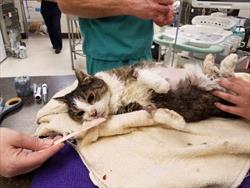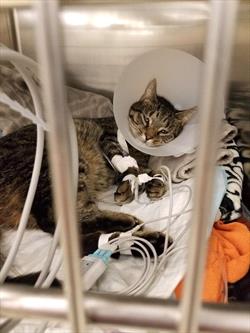Emergency visits can be a difficult experience for cats. Many emergencies involve pain, and an urgent visit to address this pain can be stressful, leading to fears and anxieties that may result in a lasting aversion to veterinary hospitals, scarring them indefinitely. Because of this, using Low Stress Handling® methods should be a priority, even in an emergency or urgent visit for care.
Communication with Veterinarians
Discuss the best options for managing stress with your veterinarian. Giving your cat antianxiety medication, such as gabapentin, two to three hours before a visit can significantly benefit your cat. Knowing your cat is less anxious may also reduce your own stress level. Calling ahead to inquire about wait times at the emergency clinic offers several advantages. It allows the clinic’s team members to assess whether your cat can remain at home longer and to arrange a scheduled arrival time, thus avoiding a long and stressful wait at the hospital.
Triage
Upon arrival, the first step is triage, which helps determine the severity of your cat’s condition. In most cases, a technician will ask about the reason for your visit, your cat’s overall health, and check vital signs. Sharing information about your cat’s previous behavior in any veterinary setting can be helpful. The approach to triage can vary depending on the facility and your cat’s condition. Remember, as the caregiver, you have the right to decline certain procedures. Technicians often suggest taking the cat to the treatment area, but requesting to accompany your cat is always an option. If your cat is less stressed with you present, which is often the case, make sure to communicate this to the team.
Cats should always be handled with minimal restraint to minimize the onset of protective emotions and defensive behaviors. Techniques such as scruffing (grasping the back of the cat’s neck), applying cat muzzles, and using full body restraint can elevate stress levels and contribute to protective emotions. Whenever possible, staying with your cat provides a way to advocate for your pet in an emergency setting, ensuring their emotional well-being.
Managing Pain and Distress
Before performing diagnostics, a veterinary team member may administer pain medication in cases where pain or injury is suspected. Any condition considered painful for humans is likely to cause pain in cats as well. Many of the diagnostic tools used by emergency facilities often involve handling areas that may be injured or painful, thereby increasing the animal’s pain and stress levels.
For instance, if a cat is suspected to have abdominal pain, the physical examination will include applying pressure to and palpating the abdominal organs, which can be painful. This may be followed by procedures like abdominal radiographs or ultrasound, which also require manipulating the painful area. Administering pain medication not only reduces the discomfort for the cat but also facilitates higher-quality diagnostics by allowing for a more thorough examination.
If pain management alone does not minimize stress during diagnostics and physical exams, sedation should be considered. Many emergency facilities are equipped with various safe and effective sedation medications that can be administered via injection, offering a truly low-stress experience for the cat. These sedatives are safe to use alongside pre-visit pain medications that the cat may have already received. Some forms of sedation can be reversed with a second injection after the procedure. Sedation allows for a more thorough exam and improves the quality of diagnostics, helping to make sure that your cat receives the best possible care.
Low Stress Handling®
Unfortunately, the overwhelming stress of the situation can make it easy to lose focus on your cat’s emotional needs. Stress, in any form, negatively affects a cat’s well-being, potentially complicating the diagnosis, delaying healing, and influencing future follow-up visits.
Caregivers also experience significant anxiety during emergency visits. This stems from concern for their pet, being in an unfamiliar environment with unknown people, enduring long wait times, and worrying about cost. Witnessing other emergencies in the waiting area can further increase anxiety, negatively impacting their cat’s well-being.
Using distractions can be beneficial under these circumstances. Offering favorite snacks, toys, or catnip can help decrease stress for you and your cat. If the visit is not due to gastrointestinal distress, such as vomiting, bringing preferred food items to the clinic such as lickable treats (e.g. Churu®), which are easily portable and favored by cats, can provide a comforting distraction during stressful times.
Toxins
If you suspect toxin ingestion or exposure, contacting the ASPCA Animal Poison Control Center can streamline your visit and reduce wait times. This center has a dedicated veterinary team specializing in feline toxicities and is reachable at (888) 426-4435. By calling them before leaving for the emergency clinic, you can receive guidance on the most appropriate course of action and obtain a case number. Please note that there is a fee for this service. With this case number, your veterinarian can access your cat’s file and create an appropriate treatment plan. In some instances, they might recommend monitoring your cat at home, potentially saving you both a trip and money.
Preparation Tips
- Be aware of occasional closures due to staff shortages. It is advisable to call ahead before leaving.
- Bring items such as a book, phone charger, and snacks for potentially long waits.
- Bringing towels and bedding from home can give your cat a sense of familiarity in an unfamiliar environment. Exercise patience, as critical emergencies will take priority.
- Have relevant medical records on hand, hard copies or downloaded, especially for visits after hours.
- Advocate for your cat’s comfort and well-being, including issues related to pain management and the need for sedation.
- Remember, you have the right to say no.




